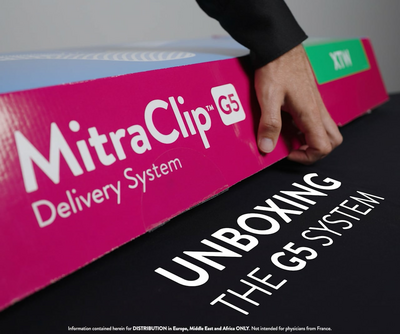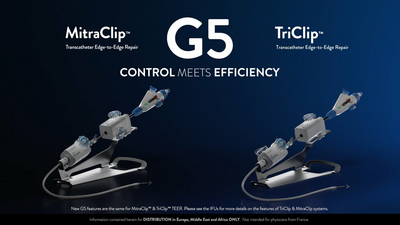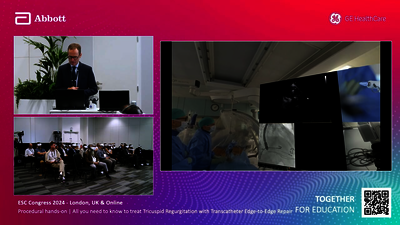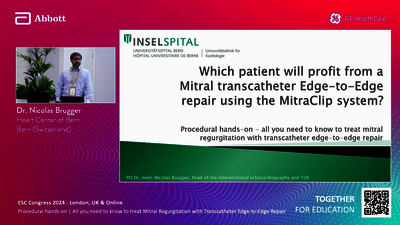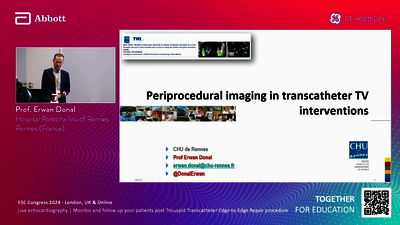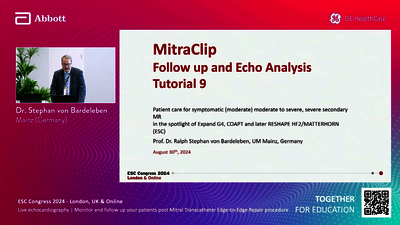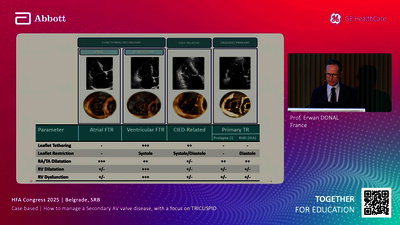MitraClip™ ist die erste minimalinvasive TEER*-Therapie, die eine lebensverändernde
Behandlungsoption für ausgewählte Patienten mit primärer Mitralinsuffizienz (PMI)
oder sekundärer Mitralinsuffizienz (SMI) bietet, die andernfalls unbehandelt bleiben
würden.1,2MitraClip™ ist der Versorgungsstandard bei TMVr basierend auf der
einzigen bewährten Mitralklappentherapie mit über 20 Jahren Erfahrung,
einer umfangreichen Sammlung klinischer Beweise und mehr als 200.000
behandelten Patienten weltweit.3
GEBAUT, UM ZU REPARIEREN. BEWÄHRT, UM WIEDERHERZUSTELLEN.
MitraClip™ bietet kompromisslose Leistung bei TEER und setzt den Standard für klinische Ergebnisse. Mit jeder Generation von MitraClip™ steht Abbott weiterhin an der Spitze der therapeutischen Expertise und arbeitet im Heartteam zusammen, um ausgewählten Patienten mit Mitralinsuffizienz (MI) dabei zu helfen, ihr Leben zurückzugewinnen.
ERFAHREN SIE MEHR ÜBER:
**Dieser Erfahrungsbericht beschreibt die Reaktion einer Person auf die Behandlung. Der Bericht dieser Patientin ist echt, typisch und dokumentiert. Er stellt jedoch keinen Hinweis, Leitfaden, Gewährleistung oder Garantie hinsichtlich der Reaktion anderer Personen auf die Behandlung dar. Die Reaktionen auf die besprochene Behandlung können variieren und sind spezifisch für den einzelnen Patienten.
**Tests durchgeführt und Daten hinterlegt von Abbott
- MitraClip™ G4 System Instructions for Use.
- Lim DS, Reynolds MR, Feldman T, et al. Improved functional status and quality of life in prohibitive surgical risk patients with degenerative mitral regurgitation after the transcatheter mitral valve repair. J Am Coll Cardiol. 2014;64(2):182–192. doi.org/10.1016/j.jacc.2013.10.021.
- Data on file at Abbott.
- Heidenreich PA, Bozkurt B, Allen LA, et al. “2022 AHA/ACC/HFSA Guideline for the Management of Heart Failure: A Report of the American College of Cardiology/American Heart Association. Joint Committee on Clinical Practice Guidelines.” J Am Coll Cardiol. 2022;28(5):E1–E167. doi.org/10.1016/j.cardfail.2022.02.010.
- Mirabel M, Lung B, Baron G, et al. What are the characteristics of patients with severe, symptomatic, mitral regurgitation who are denied surgery? Eur Heart J. 2007;28(11):1358–1365. doi.org/10.1093/eurheartj/ehm001.
- Cioffi G, Tarantini L, De Feo S, et al. Functional mitral regurgitation predicts 1-year mortality in elderly patients with systolic chronic heart failure. Eur J Heart Fail. 2005;7(7):1112–1117. doi.org/10.1016/j.ejheart.2005.01.016.
- Rottbauer WD. Contemporary Clinical Outcomes with MitraClip™ (NTR/XTR) System: Core-lab Echo Results from +1000 Patient the Global EXPAND Study. Data presented at PCR 2020.
- Maisano F. Clip Selection Strategy and Outcomes with MitraClip™ (NTR/XTR): Evidence-Based Recommendations from the Global EXPAND Study. Data presented at PCR 2020.
- Rodriguez E. Contemporary Outcomes with the MitraClip™ G4 System: Preliminary Results based on the EXPAND G4 Study. Data presented at TCT 2021.
- Vahanian A, Beyersdorf F, Praz F, et al. ESC/EACTS Scientific Document Group, 2021 ESC/EACTS Guidelines for the management of valvular heart disease: Developed by the Task Force for the management of valvular heart disease of the European Society of Cardiology (ESC) and the European Association for Cardio-Thoracic Surgery (EACTS), Eur Heart J.2022;43(7):561–632, doi.org/10.1093/eurheartj/ehab395.
- Yeo KK, Tan JWC, Muller DW, et al. Asian Pacific Society of Cardiology Consensus Recommendations on the Use of MitraClip for Mitral Regurgitation. Eur Cardiol. 2021;16:e25. doi.org/10.15420/ecr.2021.01.
- McDonagh TA, Metra M, Adamo M, et al., ESC Scientific Document Group, 2021 ESC Guidelines for the diagnosis and treatment of acute and chronic heart failure: Developed by the Task Force for the diagnosis and treatment of acute and chronic heart failure of the European Society of Cardiology (ESC) With the special contribution of the Heart Failure Association (HFA) of the ESC, Eur Heart J.2012; 42(36):3599–3726, doi.org/10.1093/eurheartj/ehab368.

